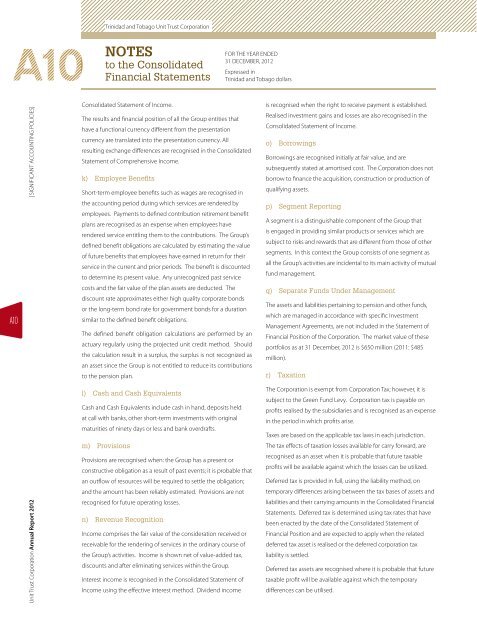p17n63qg7jmbh1r4fin71pds1p454.pdf
Create successful ePaper yourself
Turn your PDF publications into a flip-book with our unique Google optimized e-Paper software.
A10<br />
A10<br />
| SIGnIFICAnT ACCOUnTInG POLICIES|<br />
Unit Trust Corporation Annual Report 2012<br />
Trinidad and Tobago Unit Trust Corporation<br />
Notes<br />
to the Consolidated<br />
Financial Statements<br />
Consolidated Statement of Income.<br />
The results and financial position of all the Group entities that<br />
have a functional currency different from the presentation<br />
currency are translated into the presentation currency. All<br />
resulting exchange differences are recognised in the Consolidated<br />
Statement of Comprehensive Income.<br />
k) employee benefits<br />
Short-term employee benefits such as wages are recognised in<br />
the accounting period during which services are rendered by<br />
employees. Payments to defined contribution retirement benefit<br />
plans are recognised as an expense when employees have<br />
rendered service entitling them to the contributions. The Group’s<br />
defined benefit obligations are calculated by estimating the value<br />
of future benefits that employees have earned in return for their<br />
service in the current and prior periods. The benefit is discounted<br />
to determine its present value. Any unrecognized past service<br />
costs and the fair value of the plan assets are deducted. The<br />
discount rate approximates either high quality corporate bonds<br />
or the long-term bond rate for government bonds for a duration<br />
similar to the defined benefit obligations.<br />
The defined benefit obligation calculations are performed by an<br />
actuary regularly using the projected unit credit method. Should<br />
the calculation result in a surplus, the surplus is not recognized as<br />
an asset since the Group is not entitled to reduce its contributions<br />
to the pension plan.<br />
l) Cash and Cash equivalents<br />
Cash and Cash Equivalents include cash in hand, deposits held<br />
at call with banks, other short-term investments with original<br />
maturities of ninety days or less and bank overdrafts.<br />
m) Provisions<br />
Provisions are recognised when: the Group has a present or<br />
constructive obligation as a result of past events; it is probable that<br />
an outflow of resources will be required to settle the obligation;<br />
and the amount has been reliably estimated. Provisions are not<br />
recognised for future operating losses.<br />
n) Revenue Recognition<br />
Income comprises the fair value of the consideration received or<br />
receivable for the rendering of services in the ordinary course of<br />
the Group’s activities. Income is shown net of value-added tax,<br />
discounts and after eliminating services within the Group.<br />
Interest income is recognised in the Consolidated Statement of<br />
Income using the effective interest method. Dividend income<br />
FOR THE YEAR ENDED<br />
31 DECEMBER, 2012<br />
Expressed in<br />
Trinidad and Tobago dollars<br />
is recognised when the right to receive payment is established.<br />
Realised investment gains and losses are also recognised in the<br />
Consolidated Statement of Income.<br />
o) borrowings<br />
Borrowings are recognised initially at fair value, and are<br />
subsequently stated at amortised cost. The Corporation does not<br />
borrow to finance the acquisition, construction or production of<br />
qualifying assets.<br />
p) segment Reporting<br />
A segment is a distinguishable component of the Group that<br />
is engaged in providing similar products or services which are<br />
subject to risks and rewards that are different from those of other<br />
segments. In this context the Group consists of one segment as<br />
all the Group’s activities are incidental to its main activity of mutual<br />
fund management.<br />
q) separate funds under management<br />
The assets and liabilities pertaining to pension and other funds,<br />
which are managed in accordance with specific Investment<br />
Management Agreements, are not included in the Statement of<br />
Financial Position of the Corporation. The market value of these<br />
portfolios as at 31 December, 2012 is $650 million (2011: $485<br />
million).<br />
r) taxation<br />
The Corporation is exempt from Corporation Tax; however, it is<br />
subject to the Green Fund Levy. Corporation tax is payable on<br />
profits realised by the subsidiaries and is recognised as an expense<br />
in the period in which profits arise.<br />
Taxes are based on the applicable tax laws in each jurisdiction.<br />
The tax effects of taxation losses available for carry forward, are<br />
recognised as an asset when it is probable that future taxable<br />
profits will be available against which the losses can be utilized.<br />
Deferred tax is provided in full, using the liability method, on<br />
temporary differences arising between the tax bases of assets and<br />
liabilities and their carrying amounts in the Consolidated Financial<br />
Statements. Deferred tax is determined using tax rates that have<br />
been enacted by the date of the Consolidated Statement of<br />
Financial Position and are expected to apply when the related<br />
deferred tax asset is realised or the deferred corporation tax<br />
liability is settled.<br />
Deferred tax assets are recognised where it is probable that future<br />
taxable profit will be available against which the temporary<br />
differences can be utilised.



